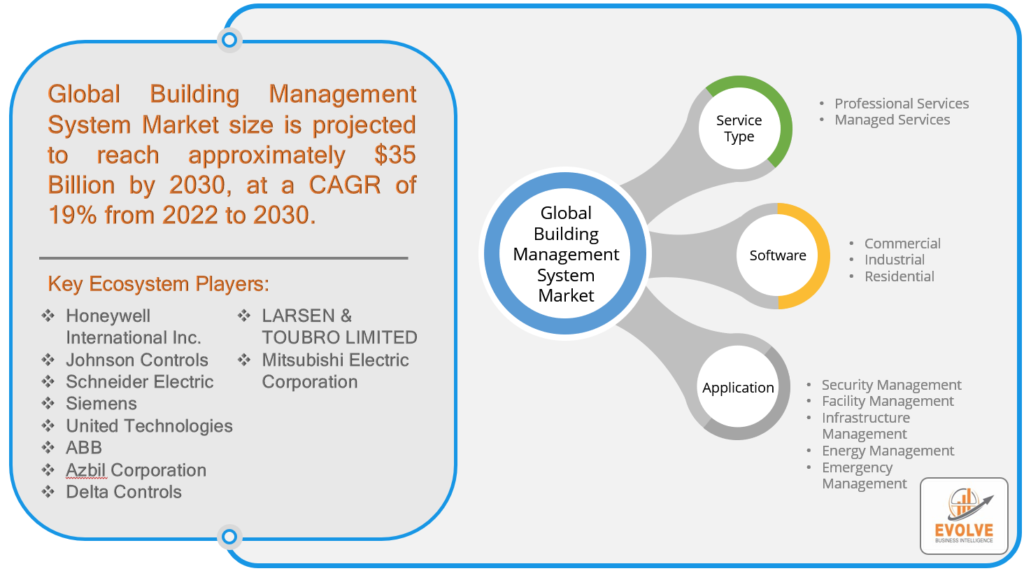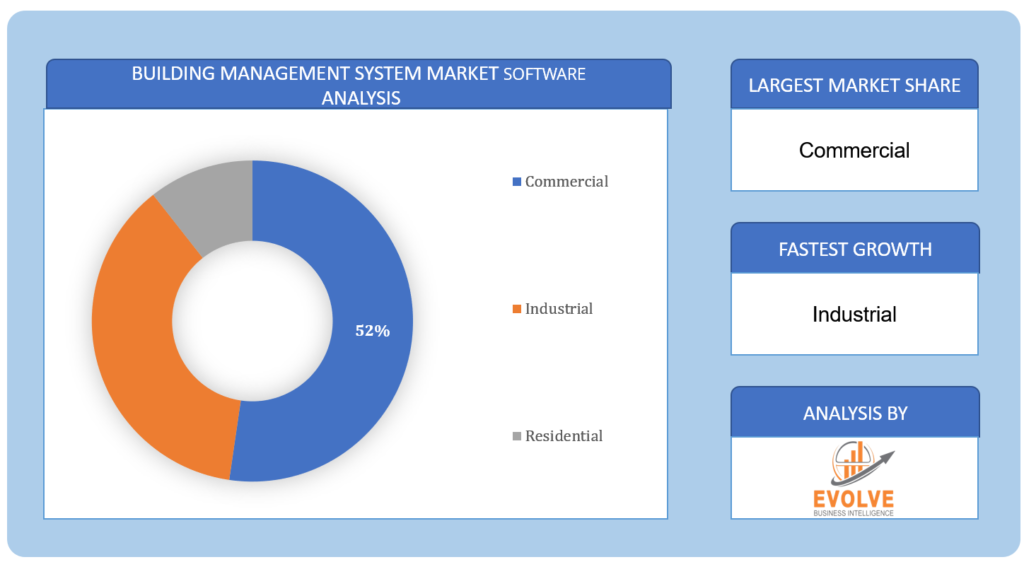Building Management System Market Analysis and Forecast 2020-2032
$1,390.00 – $5,520.00Price range: $1,390.00 through $5,520.00
Report Published on: February 25, 2025[vc_row][vc_column width=”2/3″][vc_column_text woodmart_inline=”no” text_larger=”no”]The global Building Management System market size is projected to reach approximately USD 35 Billion by 2032, at a CAGR of 19% from 2022 to 2032. A Building Management System (BMS) is an integrated system that collects and distributes information about the building and its inhabitants. The goal of a BMS is to maintain the building in optimal operation during normal and emergency conditions. Building managers use BMS data for any required building maintenance and routine and emergency maintenance. The BMS is the primary interface for building users and the primary interface for field service personnel.
COVID-19 Impact Analysis
The outbreak of COVID-19 has had detrimental effects on the worldwide building management system market as a result of travel bans being put into place. Market leaders have been confronted with numerous hardships, for instance, regulatory and policy changes, working capital management, supply chain execution, and dependency on labor. Despite these difficulties, businesses have implemented strategic cost-saving plans to cope with the pandemic’s fallout. With the need to manage and guarantee security across residential and commercial areas becoming more pressing in the post-pandemic landscape, the demand for building management systems has increased.
Building Management System Market Dynamics
 There are various drivers of growth for the building management system market, such as the need for energy efficiency, operational efficiency, and sustainability. Additionally, government regulations promoting BMS adoption across organizations are also playing a role. With rising global energy costs and stricter government sanctions, the market for BMS is expected to continue growing. BMS uses data from cloud-based analytic platforms, the Internet of things (IoT), and artificial intelligence, which makes cybersecurity and data privacy critical considerations.
There are various drivers of growth for the building management system market, such as the need for energy efficiency, operational efficiency, and sustainability. Additionally, government regulations promoting BMS adoption across organizations are also playing a role. With rising global energy costs and stricter government sanctions, the market for BMS is expected to continue growing. BMS uses data from cloud-based analytic platforms, the Internet of things (IoT), and artificial intelligence, which makes cybersecurity and data privacy critical considerations.
Drivers:
Ø The surge in demand for energy-efficient and eco-friendly buildings
The surge in demand for energy-efficient and eco-friendly buildings is increasing the Building Management System market. Building Management Systems (BMS) are designed to help manage and monitor the operations of a building, including the HVAC, lighting, security, and fire safety systems. BMS systems can help reduce a building’s energy consumption and operating costs, as well as improve its occupant comfort and safety. The increasing demand for energy-efficient buildings and the need for centralized building management and control are the major factors driving the growth of the BMS market.
Restraint:
- Lack of skilled workforce
Restraint in the building management systems includes a lack of skilled workers. The systems are complex and require regular maintenance. Without skilled workers, the systems can quickly become outdated and inefficient. This can lead to higher operating costs and reduced service levels. In addition, without skilled workers, it can be difficult to keep up with the latest technologies and trends.
Opportunity:
- The rise in demand from emerging economics
The building management systems market is expected to grow. The market is driven by the growing demand from emerging economies, the need for energy efficiency, and the increasing adoption of cloud-based solutions. Developing nations are expected to be the largest market for building management systems, due to the growing construction industry in countries such as China and India. The region is also expected to witness the highest growth rate, due to the increasing government initiatives to promote energy efficiency.
Challenges:
- Lack of awareness
One of the biggest challenges in building management systems is the lack of awareness regarding BMS. This is a huge problem because BMS is designed to save energy and money, but if people are not aware of them, they will not be used to their fullest potential. Another challenge is that BMS is often not integrated with other systems in the building, such as the heating and cooling systems, which can make them less effective. Additionally, BMS can be expensive to install and maintain, which can deter some building owners from using them.
Building Management System Market Segment Overview
Based on Service Type, the global Building Management System market has been segmented based on Professional Services and Managed Services. The Professional Services segment is the fastest growing in the global Building Management System market.
By Software
Based on Software, the global Building Management System market has been segmented based on Commercial, Industrial, and Residential. The Commercial segment is expected to be the fastest-growing in the global Building Management System market.
By Application
Based on the application, the global Building Management System market has been segmented based on Security Management, Facility Management, Infrastructure Management, Energy Management, and Emergency Management. The Facility Management segment is expected to be the largest in the global Building Management System market.
Global Building Management System Market Share, by Segmentation
 Building Management System Market Regional Analysis
Building Management System Market Regional Analysis
By region, the global Building Management System market has been divided into North America, Europe, Asia-Pacific, and the Rest of the World. The Europe region holds the largest market for the Building Management System business.
Asia-Pacific Market
The Asia Pacific region is the fastest-growing building management system market. This is because of the increasing demand for energy-efficient and green buildings in the region. In addition, the growing awareness of the benefits of building management systems, such as improved energy efficiency and better control of building operations, is driving market growth in the Asia Pacific region.
North America Market
The building management system market in North America is expected to grow. This growth is attributed to the increasing adoption of cloud-based and IoT-enabled building management solutions and is expected to drive the growth of the market in North America.
Competitive Landscape
The market comprises tier-1, tier-2, and local players. With their wide product portfolios, tier-1 and tier-2 players have a global reach. Because of their strategic innovations and broad regional presence, companies such as Honeywell International Inc., Johnson Controls, Schneider Electric, Siemens, United Technologies, ABB, Azbil Corporation, Delta Control, LARSEN & TOUBRO LIMITED, Mitsubishi Electric Corporation lead the global Building Management System business. To increase their market position and attract a wide consumer base, the businesses are employing various strategies, such as growth, product releases, and alliances.
Prominent Players:
- Honeywell International Inc.
- Johnson Controls
- Schneider Electric
- Siemens
- United Technologies
- ABB
- Azbil Corporation
- Delta Controls
- LARSEN & TOUBRO LIMITED
- Mitsubishi Electric Corporation
Scope of the Report
Global Building Management System Market, by Service Type
- Professional Services
- Managed Services
Global Building Management System Market, by Software
- Commercial
- Industrial
- Residential
Global Building Management System Market, by Application
- Security Management
- Facility Management
- Infrastructure Management
- Energy Management
- Emergency Management
Global Building Management System Market, by Region
- North America
- US
- Canada
- Mexico
- Europe
- UK
- Germany
- France
- Italy
- Rest of Europe
- Asia Pacific
- China
- Japan
- South Korea
- India
- Rest of Asia Pacific
- Rest of the World
| Parameters | Indicators |
|---|---|
| Market Size | 2030: $ 35 Billion |
| CAGR | 19% CAGR (2022-2030) |
| Base year | 2021 |
| Forecast Period | 2022-2030 |
| Historical Data | 2020 |
| Report Coverage | Revenue Forecast, Competitive Landscape, Growth Factors, and Trends |
| Key Segmentations | Service Type, Software, Application |
| Geographies Covered | North America, Europe, Asia-Pacific, Latin America, Middle East, Africa |
| Key Vendors | Honeywell International Inc., Johnson Controls, Schneider Electric, Siemens, United Technologies, ABB, Azbil Corporation, Delta Control, LARSEN & TOUBRO LIMITED, Mitsubishi Electric Corporation |
| Key Market Opportunities | The rise in demand from emerging economics |
| Key Market Drivers | A surge in demand for energy-efficient and eco-friendly buildings |
REPORT CONTENT BRIEF:
- High-level analysis of the current and future Building Management System market trends and opportunities
- Detailed analysis of current market drivers, restraining factors, and opportunities in the future
- Building Management System market historical market size for the year 2021, and forecast from 2022 to 2032
- Building Management System market share analysis at each product level
- Competitor analysis with a detailed insight into its product segment, financial strength, and strategies adopted.
- Identifies key strategies adopted including product launches and developments, mergers and acquisitions, joint ventures, collaborations, and partnerships as well as funding taken and investment done, among others.
- To identify and understand the various factors involved in the global Building Management System market affected by the pandemic
- To provide a detailed insight into the major companies operating in the market. The profiling will include the financial health of the company past 2-3 years with segmental and regional revenue breakup, product offering, recent developments, SWOT analysis, and key strategies.
[/vc_column_text][/vc_column][vc_column width=”1/3″][vc_column_text woodmart_inline=”no” text_larger=”no”][html_block id=”3961″][/vc_column_text][vc_wp_text]
Press Release
[rpwe limit=”10″ thumb=”true”][/vc_wp_text][/vc_column][/vc_row][vc_row][vc_column][vc_column_text woodmart_inline=”no” text_larger=”no”]
Frequently Asked Questions (FAQ)
[sp_easyaccordion id=”12766″][/vc_column_text][/vc_column][/vc_row]






